|
The 1962 AMA Nationals competition was considered
the first major contest for scale radio controlled airplanes. To wit, this article from the
1963 Annual edition of American Modeler, says R/C scale "finally 'came of age.'"
Proportional radio sets were becoming common and the reliability of the airborne
electronics and batteries was going up while weight and size was coming down.
Modelers were much more willing to trust the radios to safely control models that
often took many hundreds of hours to build. Sharing frequencies at or near to the
27 MHz band allocated by the FCC to R/C was still a huge risk, but the venues of
major contests provided protected areas that were far enough from most interference
sources. Unlike today's championship level models that can use 18 channels or more
for the four basic controls (rudder, elevator, throttle, ailerons) plus flaps,
retracting gear, bomb drops, opening canopies and cargo doors, throttle mixture,
navigation light control, smoke, and more, the 1962 crop was likely to have models
with less than four channels. Take a look at the detailed list of models, their
pilots, and the gear used.
Who Flew What in the American Radio Plane Championships
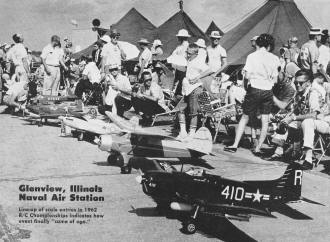
Line-up of scale entries in 1962 R/C Championships indicates how event
finally "came of age."
Glenview, Illinois Naval Air Station
With an entry list the biggest ever we are delighted to bring readers more listings
of individual fliers and their planes than ever before - some 165 for this 1962 Nationals.
As usual we made it a point to secure data sheets from all qualifiers in every R/C event,
and we obtained them from many who didn't qualify as well, but whose planes and/or radio
equipment was of special interest.
Last year's listings were presented in paragraph form, but heeding the pleas of "our
public," we return to the more popular tabular form. R/C'ers tell us it is much easier
to cull the info they want when it's presented this way ... but pity the poor typesetter!
Space is always at a premium, particularly when there are as many listings as we have
this time, so we employ quite a few abbreviations. For example: Vib (vibrator); Xstr
(transistor); Rec (receiver); Trans (transmitter); Conv (converter); Pwr (power); Sup
(supply); Mod (modified); Orig (original); Esc (escapement); Prop (proportional); Cl
1 (Class One or Rudder); Cl 2 (Class Two or Intermediate); Cl 3, (Class Three or Multi);
Comp (compound escapement); Var (variable); NCc (nickel-cadmium cells).
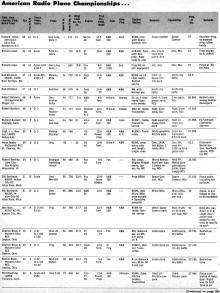 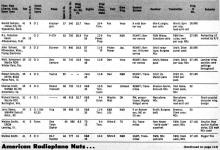 For actual controls available in the model, we
resort to the same "shorthand" we've had for years - R stands for Rudder, E for elevator,
M for Motor Control, A for aileron, T for Elevator Trim. CAR indicates coupled Rudder
and Ailerons. Any added controls we spell out. There is no indication for Steering and
Brakes - practically every plane except those in the Class 1 category (where these are
prohibited) had them. For actual controls available in the model, we
resort to the same "shorthand" we've had for years - R stands for Rudder, E for elevator,
M for Motor Control, A for aileron, T for Elevator Trim. CAR indicates coupled Rudder
and Ailerons. Any added controls we spell out. There is no indication for Steering and
Brakes - practically every plane except those in the Class 1 category (where these are
prohibited) had them.
In the Event column we list the place - if any - won in Finals, and the score in points
for best flight (or in minutes and seconds for Pylon racing planes).
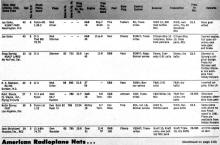 Following flyer's name, we list club affiliation,
if any. Some modelers are members of two or more clubs, but we usually have room only
for the first one he or she listed. Ham license call letters, if held, are given. Following flyer's name, we list club affiliation,
if any. Some modelers are members of two or more clubs, but we usually have room only
for the first one he or she listed. Ham license call letters, if held, are given.
Since make of glow plug, make of fuel and make of prop are important items these days,
we have added this info to listings. ("Torn." stands for Tornado propellers; TF for Top
Flite.)
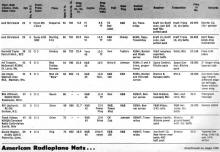
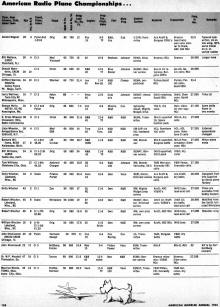 Please note info in the listings was furnished
by the participants themselves. We continue to be amazed at the variety of figures given
for such items as wing span and area of certain well known models. For example, we found
area of the Taurus quoted as both 690 and 760 square inches. Some modelers use the entire
wing to figure area, others omit the portion that passes through the body (and kit makers
vary similarly). Most modelers haven't the foggiest notion of their wing loading, so
we calculated this, where possible. Despite these vagaries, modelers declare our Nats
R/C listing is of great value. See what you can learn from this bumper crop for 1962! Please note info in the listings was furnished
by the participants themselves. We continue to be amazed at the variety of figures given
for such items as wing span and area of certain well known models. For example, we found
area of the Taurus quoted as both 690 and 760 square inches. Some modelers use the entire
wing to figure area, others omit the portion that passes through the body (and kit makers
vary similarly). Most modelers haven't the foggiest notion of their wing loading, so
we calculated this, where possible. Despite these vagaries, modelers declare our Nats
R/C listing is of great value. See what you can learn from this bumper crop for 1962!
Our very special thanks to all those who cooperated so cheerfully!
Posted June 9, 2018
|